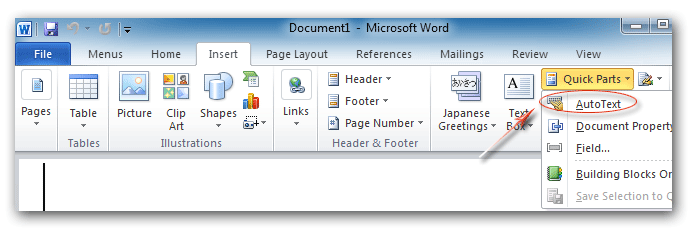
- #How to use microsoft office 2013 autotext how to#
- #How to use microsoft office 2013 autotext windows#
Using the Print What pull-down list, select AutoText Entries.If you are using Word 2007, then the steps are a bit different: On the Insert tab, in the Text group click Quick Parts > AutoText > Save Selection to AutoText Gallery. In the Document Info (or Document Properties) section of the options, choose AutoText Entries. To add a new AutoText entry, select the text that you want to store and do one of the following: Press Alt + F3.Word displays a number of different things you can print. Click the first control under the Settings heading.Click Print at the left side of the screen.Word allows you to print such a list just follow these steps if you are using Word 2010 or a later version: There are times when it may be helpful to have a printout of your AutoText definitions. There is one place where AutoText is still alive, well, and distinct-printing. Beginning with Word 2007, AutoText was absorbed into the concept of building blocks, with AutoText being just one portion of that concept. You can delete the duplicates from Normal2003.dotx, and keep only the ones that are unique to that template.AutoText has been a feature in Word since the earliest days of the program. You'll probably see a lot of duplicates, where one entry comes from Normal.dotm and the otherĬomes from Normal2003.dotx. Click Insert > Quick Parts > Building Block Organizer and examine the list of AutoText entries. Once the Normal2003.dotx template is in place, open Word 2010 again. If you find such a file, rename your current normal.dotm file to something else. With Word closed, look for a file named 'Backup of Normal.wbk' in your User Templates Folder. Specifically, you can store your AutoText and other Building Blocks in one or more custom Global Templates.

Within that folder open the folder named 14 (Word 2010 is also known as version 14). See Automated Boilerplate Using Microsoft Word for suggestions. Specify a name that makes sense for what you are creating, such as 'My AT Entries. Using the controls in the dialog box, select a location for the output file. A dialog box appears, asking you for a file name for the output file. I have Microsoft Office 2013 for Dummies.
#How to use microsoft office 2013 autotext how to#
My question: How do I edit this text I clicked on Quick Parts but dont know how to make the changes so that they appear in my AutoText. These bits of text I insert from the Quick Access Toolbar. If you don't see the file there, you need to open the folder with your language identifier (such as 1033 for English US), and possibly office 365 training center office support. Using the Print What drop-down list, choose AutoText Entries. I have three chunks of AutoText that I insert into form letters several times a day.
#How to use microsoft office 2013 autotext windows#
%appdata%\Microsoft\Document Building Blocks in the title bar of the Windows Explorer and pressing Enter. Is there any way I can get it to work like that again (I'm using Word 2013, Windows 8. This is a hidden folder, which you can reach by pasting I generally use a bunch of different Word templates, and need the Autotext entries to work in all of them, which was happening before, but now it won't. Now copy or move the Normal2003.dotx file to the same folder that contains the Building Blocks.dotx file. (Note: the original Normal2003.dot will still exist, along with the new. Then save the template, which will give it a.

Answer the prompt to convert the template to 2010 format. The title bar will include "[CompatibilityĬlick File > Info > Convert. Use the File > Open dialog (not File > New) to open Normal2003.dot. Rename it as Normal2003.dot so you can recognize it later. Not the Templates folder) on the Word 2010 computer. For several of the past iterations of Word, Microsoft has had an AutoText feature that allows users to capture a piece of text and then to use it over and over again in other parts of their. The first step is to get a copy of the Normal.dot template from Word 2003 and put it in some folder (such as the Documents folder - but They can then be used directly, or moved to a different template by using the Building dotx file stored in the same folder with Building Blocks.dotx. What isn't often mentioned is that Word 2007 and later will load AutoText (or other building blocks) from any. Starting with Word 2007, the entries that come with Office are stored in a Building Blocks.dotx file. Word saves custom AutoText entries in templates, by default in Normal.dot (in 2003 and earlier) or Normal.dotm (in 2007 and later).


 0 kommentar(er)
0 kommentar(er)
